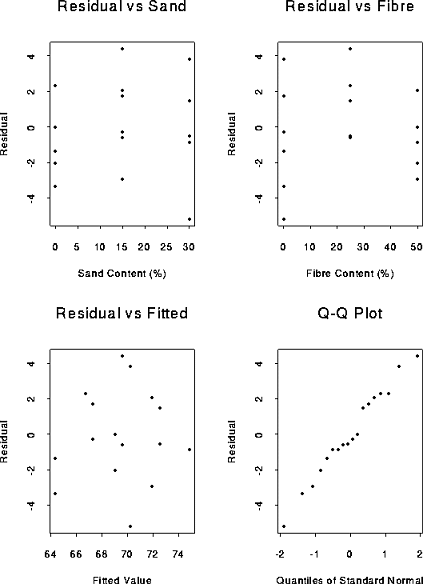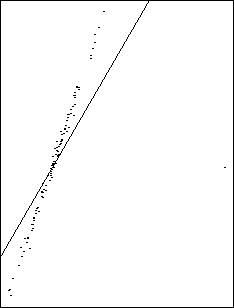Reading: Chapter 9.
Sand and Fibre Analysis so far:
Next

Remark: This can be done in the quadratic model too.
Conclusion:
![]() ;
Sand has an impact on Y.
;
Sand has an impact on Y.
Similarly
![]() .
.
Informal methods:
Look for:
Here are some plots:

Conclusions from the plots.
Warning: don't look too hard for patterns; you will find them where they aren't.

Conclusion: evidence of need for the F2 term is weak. We might want more data if the ``optimal'' Fibre content is needed.
Notice as always: statistics does not eliminate uncertainty but rather quantifies it.
Recall that


Warning: the N((0,1) approximation requires normal errors.
Criticism of internally standardized residuals. If the model is
bad particularly at point i then including point i pulls the fit
towards
Yi, inflates
![]() and makes the badness hard to see.
and makes the badness hard to see.

Suggestion: for each point i delete point i, refit the model,
predict Yi (call the prediction
![]() where the (i) in the
subscript shows which point was deleted.
We then get case deleted residuals
where the (i) in the
subscript shows which point was deleted.
We then get case deleted residuals
For the insurance data we can look at the residuals after various model fits.
data insure; infile 'insure.dat' firstobs=2; input year cost; code = year - 1975.5 ; proc glm data=insure; model cost = code ; output out=insfit h=leverage p=fitted r=resid student=isr press=press rstudent=esr; run ; proc print data=insfit ; run; proc glm data=insure; model cost = code code*code code*code*code ; output out=insfit3 h=leverage p=fitted r=resid student=isr press=press rstudent=esr; run ; proc print data=insfit3 ; run; proc glm data=insure; model cost = code code*code code*code*code code*code*code*code code*code*code*code*code; output out=insfit5 h=leverage p=fitted r=resid student=isr press=press rstudent=esr; run ; proc print data=insfit5 ; run;The full output is here but I reproduce parts of it here.
For the linear fit:
OBS YEAR COST CODE LEVERAGE FITTED RESID ISR PRESS ESR
1 1971 45.13 -4.5 0.34545 42.5196 2.6104 0.36998 3.9881 0.34909
2 1972 51.71 -3.5 0.24848 48.8713 2.8387 0.37550 3.7773 0.35438
3 1973 60.17 -2.5 0.17576 55.2229 4.9471 0.62485 6.0020 0.59930
4 1974 64.83 -1.5 0.12727 61.5745 3.2555 0.39960 3.7302 0.37758
5 1975 65.24 -0.5 0.10303 67.9262 -2.6862 -0.32524 -2.9947 -0.30626
6 1976 65.17 0.5 0.10303 74.2778 -9.1078 -1.10275 -10.1540 -1.12017
7 1977 67.65 1.5 0.12727 80.6295 -12.9795 -1.59320 -14.8723 -1.80365
8 1978 79.80 2.5 0.17576 86.9811 -7.1811 -0.90702 -8.7124 -0.89574
9 1979 96.13 3.5 0.24848 93.3327 2.7973 0.37001 3.7222 0.34912
10 1980 115.19 4.5 0.34545 99.6844 15.5056 2.19772 23.6892 3.26579
In this case it is the pattern of the residuals, together with the big
improvement in moving to a cubic model (as measured by the drop in ESS),
which convinces us that the linear fit is bad. You will see that the
leverages are not too large, that the internally studentized residuals are
mostly acceptable though the 2.2 for 1980 is a bit big. However the
externally standard residual for 1980 is really much too big.
Now for the cubic fit:
OBS YEAR COST CODE LEVERAGE FITTED RESID ISR PRESS ESR
1 1971 45.13 -4.5 0.82378 43.972 1.15814 1.21745 6.57198 1.28077
2 1972 51.71 -3.5 0.30163 54.404 -2.69386 -1.42251 -3.85737 -1.59512
3 1973 60.17 -2.5 0.32611 60.029 0.14061 0.07559 0.20865 0.06903
4 1974 64.83 -1.5 0.30746 62.651 2.17852 1.15521 3.14570 1.19591
5 1975 65.24 -0.5 0.24103 64.073 1.16683 0.59104 1.53738 0.55597
6 1976 65.17 0.5 0.24103 66.098 -0.92750 -0.46981 -1.22205 -0.43699
7 1977 67.65 1.5 0.30746 70.528 -2.87752 -1.52587 -4.15503 -1.78061
8 1978 79.80 2.5 0.32611 79.166 0.63372 0.34066 0.94039 0.31403
9 1979 96.13 3.5 0.30163 93.817 2.31320 1.22150 3.31229 1.28644
10 1980 115.19 4.5 0.82378 116.282 -1.09214 -1.14807 -6.19746 -1.18642
Now the fit is generally ok with all the standardized residuals being fine.
Notice the large leverages for the end points, 1971 and 1980.
Finally the quintic:
OBS YEAR COST CODE LEVERAGE FITTED RESID ISR PRESS ESR
1 1971 45.13 -4.5 0.98322 45.127 0.00312 0.03977 0.18583 0.03445
2 1972 51.71 -3.5 0.72214 51.699 0.01090 0.03417 0.03924 0.02960
3 1973 60.17 -2.5 0.42844 60.232 -0.06161 -0.13462 -0.10780 -0.11685
4 1974 64.83 -1.5 0.46573 64.784 0.04641 0.10487 0.08686 0.09095
5 1975 65.24 -0.5 0.40047 65.228 0.01181 0.02520 0.01970 0.02183
6 1976 65.17 0.5 0.40047 64.925 0.24502 0.52270 0.40868 0.46897
7 1977 67.65 1.5 0.46573 68.392 -0.74249 -1.67794 -1.38974 -2.67034
8 1978 79.80 2.5 0.42844 78.981 0.81942 1.79036 1.43365 3.47878
9 1979 96.13 3.5 0.72214 96.543 -0.41296 -1.29407 -1.48622 -1.46985
10 1980 115.19 4.5 0.98322 115.110 0.08038 1.02486 4.78917 1.03356
Now notice that the leverages at the end are very high and that although
the fit is good the residuals at 1977 and 1978 are definitely too big.
Overall the cubic fit is to be preferred but does not provide reliable
forecasts nor a meaningful physical description of the data. A good model
would somehow involve economic theory and covariates, though there is
really very little data to fit such models.
The graphs produced by proc plot is SAS are intended to be printed on the most old fashioned printers. Better graphs can be made using proc gplot. The following code:
data plaster;
infile 'plaster.dat';
input sand fibre hardness strength;
proc glm data=plaster;
model hardness = sand fibre ;
output out=outdat p=fitted r=resid h=leverage
cookd=cookd dffits=dffits rstudent=rstudent;
run;
proc rank data=outdat normal=vw out=outdat1;
var resid;
ranks normscr;
run;
proc gplot data=outdat1;
title3 'Residual Plots';
plot resid*sand ;
plot resid*fibre ;
plot resid*fitted ;
plot resid*normscr;
run;
produces much higher quality graphs. First in proc glm
we regress hardness on sand and fibre content. The output
statement saves the residuals and fitted values, along with
some regression diagnostics used in the next few lectures
in a new data set called outdat. Then proc rank
computes the normal scores which corresponding to the residuals and
adds these normal scores to the data set making the new data set
outdat1. Finally proc gplot graphs resid against
sand, fibre, fitted value and the normal scores. The graphs which
result are much easier to interpret.